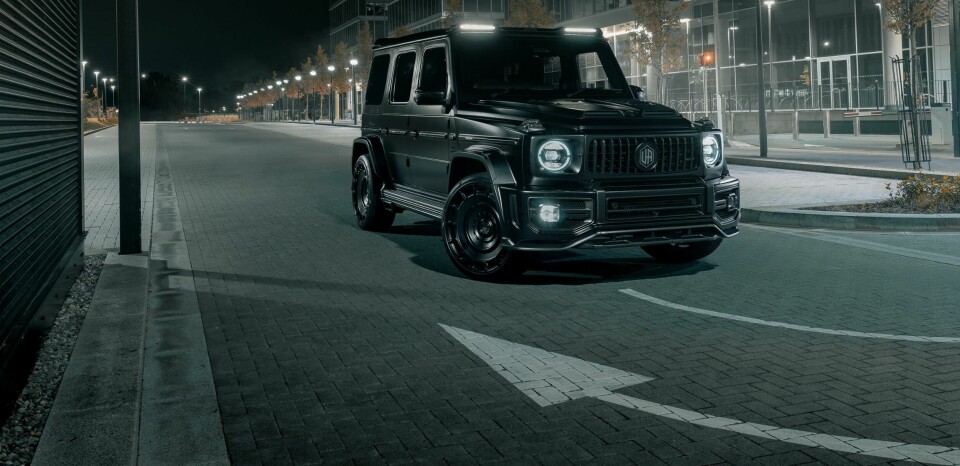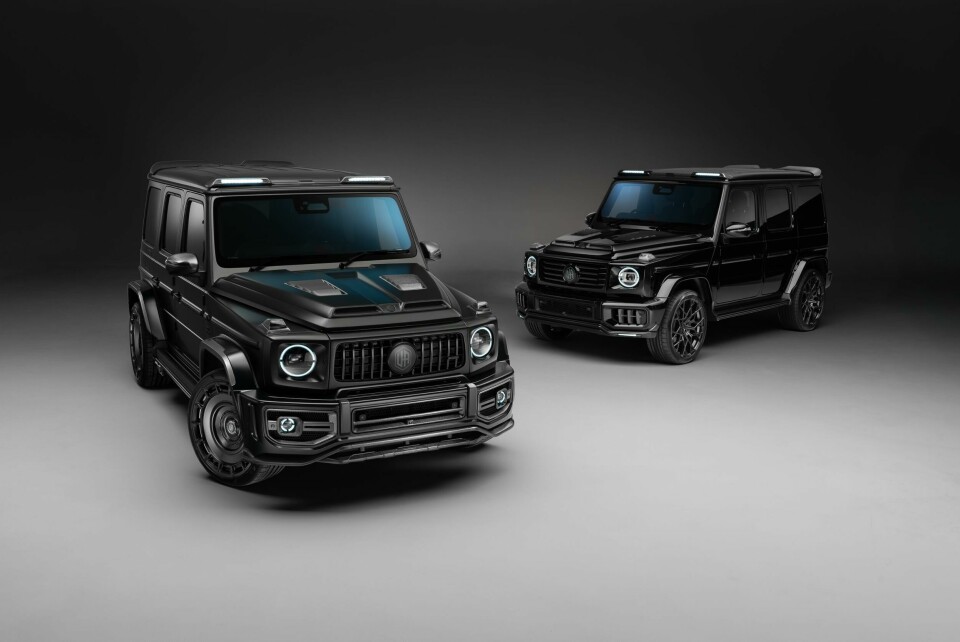
Urban Automotive: “OEM+ is about complementing already great designs”
Car Design News sat down with Urban Automotive founder Simon Dearn to discuss modification, styling and why certain cars just make sense for ‘OEM plus’ work
Car modification has always split opinion, but it seems somewhat ironic amid the recent boom in restomods – both from third-parties and the original manufacturers. Even a casual glance at ‘modding’ reveals some common themes – overt bodywork and interiors, upgraded lighting and exhausts and perhaps some additional tech not offered as standard.
The usual suspects come in the shape of the Mercedes G-Class and the Land Rover Defender, primarily with the earlier models but more recently with the modern relaunches. This is where the split becomes clear: contemporary modification is just that, with very different approaches to styling than that of a restomod which seems to stick more closely to the original format. It is about amplifying the original design in a way that stands out and finding the balance between accentuation and styling for styling’s sake.

One company that seems to be riding the contemporary wave is Urban Automotive, which has given its own touch to everything from the Defender and Range Rover to models from Bentley, Rolls-Royce and Lamborghini. Following the launch of its latest widebody and aero kits for the W465 G-Wagon, which uses “an insane amount of carbon-fibre,”Car Design News sat down with founder Simon Dearn to discuss the origins of the company, why styling is not a taboo word in the modification world and why Urban is on a mission to change the perception of the modding scene.
Car Design News: How did Urban Automotive start?
Simon Dearn: I used to work in IT and became fed up of the rat race, so set up what I thought was going to be a bit more of a lifestyle business, selling a few cars and playing golf. I thought it would all be very easy. We were selling cars from my house and then a small unit, but I found out that it was extremely difficult to sell sports and performance cars when you’re competing against massive players in that space.
I stumbled across the old Defender and found that it was very modifiable at the time, with a big jump between the retail and modified price. We built our first car and it sold within two or three days. For the last two years of Defender production (prior to the new generation) I think we went through around 300 of them. From there we started to tool our own products and make our own items for the Defender, with everything we earned going back into the business.
![Simon Dearn, founder of Urban Automotive Simon Dearn Urban Automotive DeSimon Dearn Urban Automotivegn_-4[2]](https://image.cardesignnews.com/437205.webp?imageId=437205&width=960&height=1442&format=jpg)
CDN: How did you know which modifications to make and where? Was it just trial and error?
SD: I guess there’s an element of that, but sometimes you’ve just got an eye for it. You know if someone dresses well, don’t you – it’s a similar thing when it comes to choosing those combinations, be it ride height, wheel offsets, the overall look you’re trying to create.
You wouldn’t necessarily dress a cool blacked-out city car as an off-roader with a roof rack, ladder and side box, for example. We’ve done a good job of using other people’s successful design direction which helped give us a route to go down.
CDN: How did the design process work to start with?
SD: Initially we used design houses. We had no internal expertise apart from me doing some sketches on paper and sending it to design companies that did the job from beginning to end. It wasn’t until we moved on to more modern cars that we started to bring that expertise in house and do the Alias modelling and so forth ourselves. When you use external contractors, you’re always sharing the work with someone else, which is fine when you’re doing one body kit over a three or four month period. But as you start to do multiple projects at the same time and they begin to dovetail, you soon realise that the expertise needs to come in house.
Our OEM+ mentality is about complementing the manufacturer’s already-great design
CDN: What does the team look like now?
SD: We’ve got six designers in the team and that consists of a mixture of engineering, Alias A-surface modelers and B surface designers as well. Over the years we’ve evolved from creating a fantastic A surface and using handmade fittings and brackets to – with the evolution of 3D printers – almost replicating OEM internals.
CDN: Do you find any challenges with the sensors embedded in modern cars – do modifications get in the way?
SD: All of the guys in the team are ex-OEM so they know the importance of having a brake sensor or a radar at the right angle to avoid errors when we apply our parts. You don’t want to turn the car on and presented with a Christmas tree of error lights on the dashboard.
The first steps we take are to adhere to manufacturing standards around fit and finish and that all sensors work with the geometries of the modified car. Sometimes it’s tough because we want to try and design something that sits outside those parameters, but we just have to make everything work correctly. There is still a stigma with modification and changing the OEM spec on a car. That’s something we really try to promote: that our OEM plus mentality is about complementing the manufacturer’s already-great design.
CDN: So modification still ruffles some feathers, or are things changing a little bit?
SD: I think with our OEM plus look there are customer that have said they previously would never have considered a modified car. They like that you get some opulence and individuality without looking completely garish. We’ve definitely convinced and changed a lot of people’s minds. I’d like to sit down with some of the top OEM designers and just have a coffee, talk about cars and designs and get their perspetive – because in general they can’t push the boundaries too far.
CDN: Have you ever had any launches that tanked?
SD: In the past, we released a Cullinan kit and it was the first time that anything got absolutely battered. As soon as we released it on social media, the comments were horrible. I took it down, removed the bumper from production and shelled out on a huge redesign of the bumper and did it again. I’m not pigheaded: when I get something wrong and I receive enough feedback, we’ll redesign it – even if it means throwing the tooling in the bin and starting again. It has to be right.
CDN: Lighting seems to be a means of differentiation between brands at an OEM level. How are you looking at that as a way to stand out?
SD: Probably once we began to partner with lighting companies. We use Lazer for our high power lights, a British company with fantastic quality and from tens of thousands of lights we’ve not seen one go faulty. We also use a company called Nolden for all of our daytime running lights, which they specialise in.
There was a focus for many years on straight DRLs – everyone had one – but then they started bringing out round, square and now hexagonal as we can see on Lamborghinis and things like that. It’s quite good because they keep bringing out these new technologies and it feels a little bit OEM because we’re thinking one or two years ahead, we’re not reactive on what we’re designing. We’re thinking about lots of different applications and lighting comes together with everything else is a key thing we consider.
OEM designers have done a fantastic job for their client base. We’re just styling the vehicle for ours
CDN: What kind of inspiration do you draw from away from cars, be it boats, watches, art, fashion…
SD: All of the above. I’m quite big on design as a whole, and I’m really intrigued by interior design, particularly in places like the UAE. There’s a big fusion at the moment between cars and fashion and lifestyle brands moving into real estate and branded apartments. Give us two or three years more and I think the Urban brand will be established enough to follow that path, with apartments that feature nice cut walnut with carbon fibre trimmed in. With a little bit more maturity and experience, it does push you to look at other areas.
CDN: Watches… Any particular brands that stand out to you?
SD: I’m relatively classic. It’s Rolex, AP and Patek. I started with a Hublot Big Bang, and I think its value halved by the time I sold it, so never bought another one.
CDN: The G Wagon seems to be a staple for modders in the same way that the Defender is. Why do you think is?
SD: Anything that makes a statement to begin with fits our criteria. You need the initial desirability and something that holds its value. For example, a G Wagon is hugely expensive but hugely popular, there’s an order book that’s 18 months long. We know that the car is desirable and will happily carry a full modification programme of around £65,000. With other cars – even in a similar bracket – the minute you drive them off the forecourt they’ve dropped by 20%. By contrast, the Range Rover Sport almost paid its initial investment within six or eight weeks of launch. The Defender has been crazy for us too, probably in excess of 5,000 cars.
CDN: Would you ever consider doing a concept car, or perhaps even your own dedicated Urban production car?
SD: I’ve looked at that many times. It would be fantastic and I’ve got lots of ideas about what would look cool, taking all of the cues of what we’ve done over various different vehicles and pulling it all together. Nothing any time soon, though, that’s for sure.
CDN: Do you find yourself doodling and sketching now and again?
SD: All the time.
![Styling involves sketching too Simon Dearn Urban Automotive DeSimon Dearn Urban Automotivegn_-6[30]](https://image.cardesignnews.com/438494.webp?imageId=438494&width=960&height=640&format=jpg)
CDN: You often use the word styling in press materials, which OEM designers tend to avoid. Why have you embraced that term?
SD: Across the vehicles that we enhance and modify, the OEM designers have done a fantastic job for their client base. We’re just trying to style the vehicle for our client base. That’s why we say that because I do believe that we’re styling it in a way that doesn’t appeal to the masses.
CDN: Where should we expect to see Urban next?
SD: We’ve got a stand at Goodwood, so it’s the first time we’ve gone all out and “OEM size” with seven or eight cars. We’re partnering with our US wheel partner, Vossen, so they’ll have a really cool car on display with some fantastic new forged wheels. It should be fun.



















